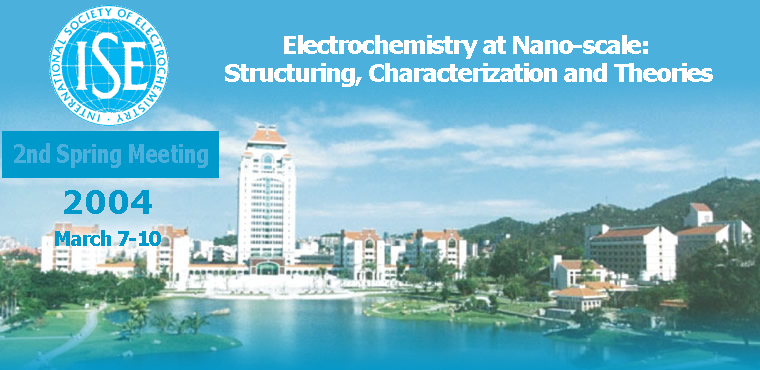To coordinate this meeting, a post-conference workshop
on Nanoscience will be organized in Beijing on March 13-15 by Institution
of Chemistry and Nano Science and Technology Center, Chinese Academy
of Sciences. http://www.casnano.cn.
The registration date: March 13. The format of the work
will be round table discussions on some topics related to developments
of nano-electrochemistry and nano-surface science.
Registration fee:
1. USD 160 (including one day tour in Beijing on March15)
2. USD 130 (not including one day tour in Beijing on March 15)
Contact : Prof. L. J. Wan
(wanlijun@iccas.ac.cn)
more details:
Post-conference
Symposium
March
13-15, 2004
Beijing
1.
Registration
The registration
fee for the participant is US$160 which includes the post conference
tours, and US$130 without the post conference tours. All participant
may attend the welcome reception on March 13, the coffee and refreshments
during the breaks, and the night banquet on March 14.
2.
Conference Venue
Friendship
Hotel, Beijing
3.
Hotel Accommodation
Friendship
Hotel, Guibin Building, Standroom, RMB450/day, including one person's
breakfast;
Friendship
Hotel, Yibin Building, Standroom, RMB400/day, including two persons'
breakfast;
Friendship
Hotel, Yibin Building, Standroom, RMB380/day, including one person's
breakfast.
4.
One-day Excursion
1.
The Great Wall and Ming Tombs
|  |
The Great Wall
China's Great Wall is the only man-made object visible from
satellites and is one of man's most remarkable accomplishments.
Construction of the Great Wall began in the 7th century
B.C.. This magnificent wonder starts at Shanhai Pass in
the east and ends at Jiayu Pass in the west, stretching
more then 6,000 kilometers. |
|  |
The Ming Tombs
The Ming Tombs are the burial ground of thirteen Ming Dynasty
emperors. Of these thirteen tombs, only two, Dingling and
Changling, are open to the public. Changling, the largest
and the oldest of the thirteen, is Emperor Zhu Di's tomb.
Dingling is the tomb of Emperor Zhu Yijun, and is the only
on to be excavated so far. |
2. Forbidden City, Temple of Heaven, Summer Palace
|  |
The Forbidden City
The Forbidden City is China's most imposing architectural
masterpiece. It represents many aspects of China's long history
and is the largest museum of oriental art in the world. Located
in the center of Beijing, the Forbidden City was built between
1406 and 1420. Twenty-four emperors of the Ming and Qing Dynasties
once lived there. The entire palace covers an area of 72 hectares
and boasts over 9,000 rooms and halls. Walking through the
palace, visitors will have the felling of passing through
a historical corridor. |
|  |
The Temple of Heaven
Located in the southeast of Beijing, the Temple of Heaven
was built in 1420. Ming and Qing emperors went there to worship
heaven and pray for good harvests. Different from the Forbidden
City with yellow tiles and red walls, this temple adopts blue
as its major color, suggesting the sky. |
|  |
The Summer Palace
Summer Palace, the largest garden and twenty kilometers northwest
of Beijing, has a history of over eight hundred years. It
was the place where the imperial families of the Qing Dynasty
handled government affairs, spent summer time, celebrated
birthdays and simply came for relaxation. |
